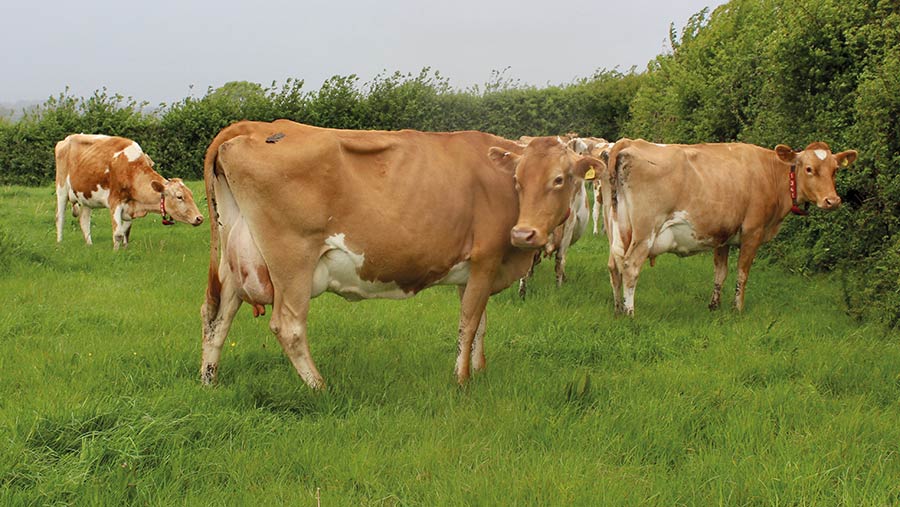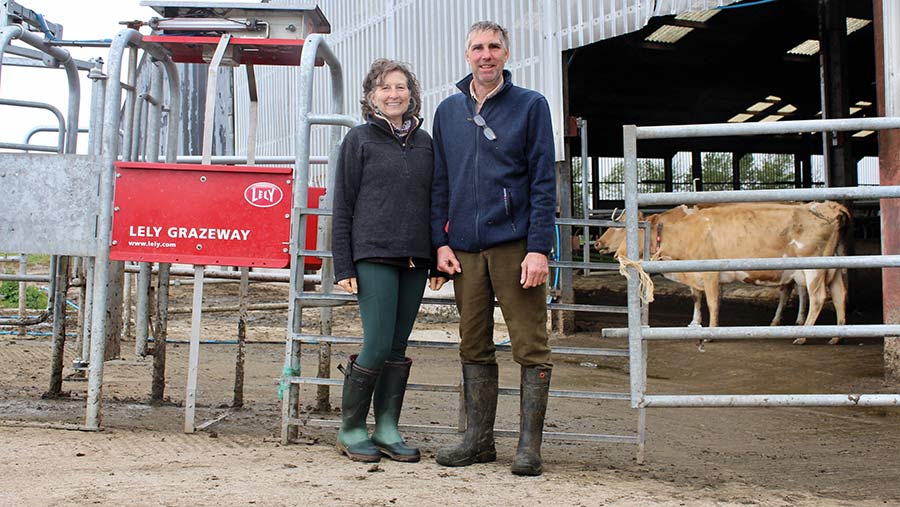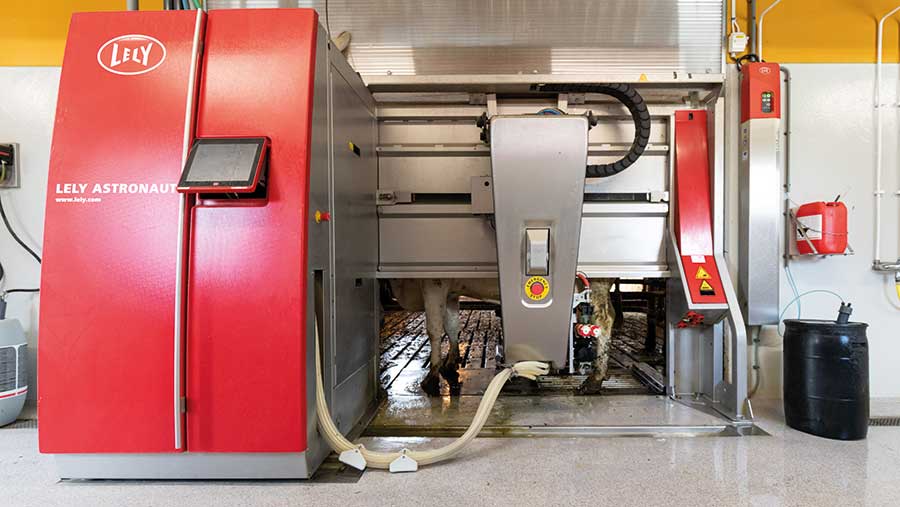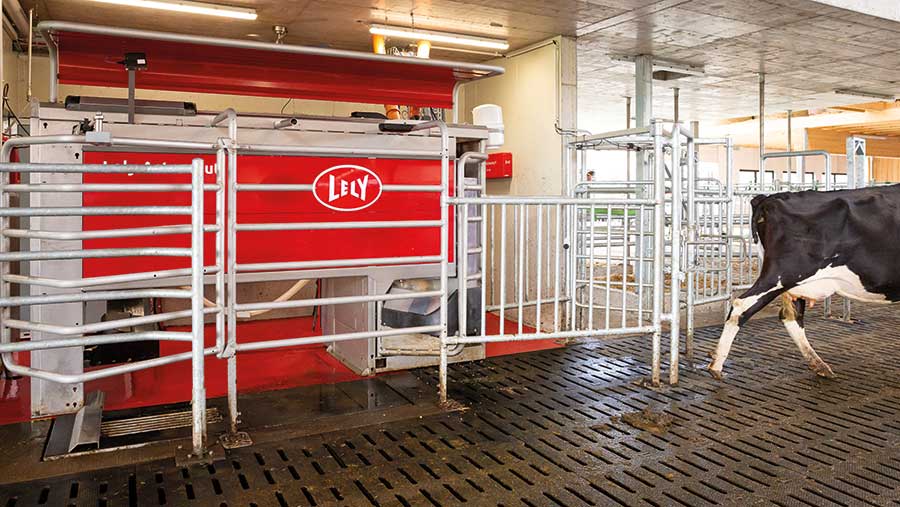Benefits of robotic milking in a pasture-based system
 Overton Farm's cows © Lely
Overton Farm's cows © Lely Combining grazing with robotic milking has lifted grass and milk yields at Overton Farm, Somerset, where David Paull and Rosie Sage have three robots to milk their 180-cow organic herd.
Annual yield has increased by an average of 1,000 litres a head in a grazing system that now grows about 15% more grass.
The couple, who trade as Olive Farm (Babcary), believe those improvements come from better grassland management and use, with a more relaxed cow that is fed to yield.
See also: How an Irish farmer combines grazing with milking robots

Rosie Sage and David Paull © Lely
Farm facts
- 130ha (321 acres) farmed
- 75% of milk produced sold to Berkley Farm Dairy
- Remainder processed on site as raw milk, yoghurt and cream under the Hurdlebrook brand
- 4.9% rolling butterfat average and 3.6% protein
Yet robot milking had never been their ambition.
When they installed a 16/32 swingover, they expected it to be the last parlour they would install during their farming career.
However, a rethink was needed when their herdsman left to pursue a share-farming opportunity.
“We were very happy with the swingover and we had a really amazing chap working for us, but we knew it would be a struggle to get someone just as good to replace him, because we had found it difficult to get relief milkers,” says Ms Sage.
“We needed to be confident that we could get those cows milked.”
Irish study tour
As grass-based milk producers, they had not considered robot milking until friends who run a similar system saw it in action on grazing farms during a study tour in Ireland.
“Within a month, we went to Ireland ourselves for our own study tour,” Ms Sage recalls.
They were convinced after visiting a farm that had a similar layout to Overton Farm – “long and thin with the infrastructure at one end” – and watching the cows walking to and from the robots, she says.
“This farm was a bit like the Australian outback, with the furthest paddocks quite some distance from the parlour, but it worked. We were really blown away.”
They opted for three Lely Astronaut A4s retrofitted into existing housing in 2018, 40% funded by a Rural Development Grant.
A grant application was submitted in March, construction work started in mid-June and cows were being milked in the robots five weeks later.
Lely provided advice on how to set up a grazing system that would be compatible with the robots.
Depending on the time of day, the ABC system (which divides grazing into three blocks) and Grazeway segregation gate automatically draft cows on one of three routes towards pasture, giving access to fresh grazing every eight hours.
If cows come back to the gate within five hours of milking, they can go to a new break, but if they have not been milked for more than five hours, they are sent to the robot first.
Grazing infrastructure
Paddocks are accessed by a network of tracks.
The farm already had many tracks created from concrete railway sleepers and some of these were lifted and relocated to provide the required layout for the ABC system.
Grass is allocated on a “40, 40, 20” system, with the herd getting the smaller grass allocation – half the grazing area of the other paddocks – at night.
The parcel of land the cows are directed to changes every eight hours on a set gate time.
The 20% allocation of grass in Block C is used for evening/night grazing to encourage cows to leave the paddock at night, which can otherwise prove difficult.
They present themselves for milking, then move to the larger 40% grazing area in block A.

© Lely
“I look at it as breakfast, dinner and tea – and tea is the 20% because we don’t want them staying in that paddock for long.
“We want to give them the incentive to move to be milked at 2am or first thing in the morning,” Ms Sage explains.
When the cows are at grass, between March and November, they visit the robot an average of 2.2 times every 24 hours.
Paddocks are grazed from 2am-10am, 10am-6pm or 6pm-2am.
Cows soon learned when the gate is about to switch to a new paddock.
“If a cow has been milked and there are a few minutes to go before the gate opens towards fresh pasture, we see her walk away and return as soon as the timer opens that gate. They seem to have an in-built clock,” says Ms Sage.
Targeted concentrates
Since installing robots, yield in the pedigree Guernsey herd has increased by an average of 1,000 litres a cow, to 5,500 litres, which Mr Paull puts down to a combination of factors.
The swingover had flat-rate feeders, so every cow was fed the same.
This, says Mr Paull, was inefficient in a system that runs spring- and autumn-calving cows together.
Cows are now fed to yield in the robots and can, therefore, achieve their potential, he adds.
Allowing cows to present themselves for milking, instead of having those intervals dictated by a clock, is also a reason for the higher milk production, Mr Paull reckons.

© Lely
Improvements made to grassland management is another.
“I think we grow more grass because of the way we graze with the robots: probably 10-15% more,” he says.
“Grass use has got to be good; if we get it wrong the cows will stay down the field because they will have no incentive to come back to be milked, or they might return to the robot too often.
“We have to be on the ball each day, managing the fencing well so that we get the allocation right.”
As far as possible, the cows do not walk over grass that has just been grazed.
“It does happen sometimes, but never more than over two feeds,” says Ms Sage, who was surprised by how quickly the cows adapted to robot milking.
“It took the humans longer. At the beginning we were constantly thinking about where the cows were, whether they were in paddock A, B or C.”
Heifers easily trained
Training heifers to be milked in a robot is no more challenging than in a conventional parlour, she adds.
“We send a cow in front of a heifer to the robot or paddock. When the heifer has a cow marching in front of her, she will follow.
“Some grazing farmers tell us that there is plenty of labour, but while that may be the case for now, young people coming out of college and into farming are less inclined to want to roll their sleeves up. But what they are interested in is technology.”
From their own experience, the couple believe that the accepted metric of one robot to every 60 cows does not apply to grazing herds.
“With lower-yielding cows, and especially so in a split block-calving herd, you can milk more than 60 cows in one machine.
“Stale cows might only be milked once a day and that frees up time for fresh calvers to make up the capacity,” says Mr Paull.
